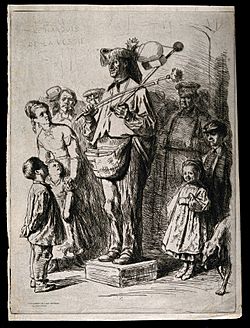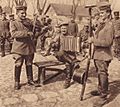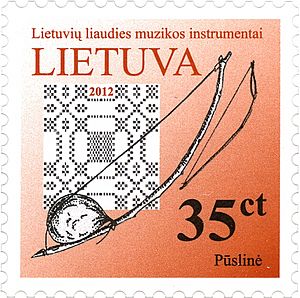Bladder fiddle facts for kids

"King of the Bladder." A man stands on a box holding a two-string bladder-fiddle. The mid-1870s image, a caricature, shows a perception that something is wrong with the musician.
|
|
| String instrument | |
|---|---|
| Other names | drone, drone-and-string, boomba, bumbass, stamp fiddle, stumpf fiddle, pogo cello, Devil's stick, Devil's violin, boom bass, hum strum, teufel stick, stomp stick, Teufelsgeige (German, devil's fiddle), Bettelgeige (German, beggar's fiddle), saubass (Austrian-German), luk muzycyny (Polish), Diabelskie skrzypce (Polish, Devil's fiddle), rabel (Spanish), basse de Flandre (French, Flanders fiddle). |
| Classification | String, percussion |
| Hornbostel–Sachs classification | (MIMO puts all bumbasses together, whether percussion or fiddles. Hornbostel-Sachs doesn't consider number of strings. Drums and bladders not considered for resonators (only gourds).
Other options musical bows
|
| Related instruments | |
|
|
The bladder fiddle is a unique folk instrument that was once popular across Europe and the Americas. It started as a simple stringed instrument. It had a long stick, one or more thick strings, and a pig's bladder that made the sound louder. Musicians played it by rubbing a notched stick or a horsehair bow across the strings.
Over time, this instrument changed a lot. Today, you can find two main types. One is still played with a bow, like in Lithuania. The other is a percussion instrument, used widely around the world.
Contents
How the Bladder Fiddle Changed Over Time
The bladder fiddle began as a bowed instrument. It used a flexible stick, like a musical bow, for its body and neck. An inflated animal bladder was placed between the stick and the string to help the sound. Some versions, like those in Poland, Lithuania, and the Netherlands, had up to three strings. Others, like the Flanders fiddle, had only one string.
To play it, musicians would draw a bow across the string or strings. Pressing down on the string would change the note. Having more strings allowed players to create simple tunes. They could also play along with other instruments.
In some places, the instrument changed. In Holland, by the late 1600s, the pig's bladder was replaced. A drum-like circle was used instead. This drum was wedged between the stick and a single string. This version was called the bumbass.
When people moved from Europe to the United States, they brought the bumbass with them. In America, it became part of the Pennsylvania Dutch culture. It is still used today as a percussion instrument called the boomba. You can also see it at German heritage festivals in places like Tomball, Texas.
On percussion versions, the drum is turned sideways. The string might still be there, but it's often not played with a bow. Instead, the stick becomes a drumstick. The instrument is now hit or stamped on the ground. It's known by many names, like boomba, stamp fiddle, or pogo cello. Sometimes, the string is replaced by a spring, or removed completely. The Polish Diabelskie skrzypce [pl] (Devil's fiddle) often has no string. But it might have a violin-shaped piece of wood to remember its past.
This percussion instrument is used in many countries. In Denmark, it's called the Rumsterstang. In Germany, it's a Teufelsgeige. The name boomba likely comes from the German word Bumbaß. This means "humming bass."
During World War I, German soldiers made their own versions. They used a tin can instead of a pig's bladder. They played it with a notched stick. Other instruments were made using a wooden box for the sound.
Today, there are still two types: bowed and percussion. The percussion type is often beaten with a stick. It is also stamped on the ground to shake bells and cymbals attached to it. It might or might not have a string.
Other Names for the Bladder Fiddle
This instrument has many different names around the world:
- In Germany, it's called the bumbass, Teufelsgeige (devil's fiddle), or Bettelgeige (beggar's fiddle). Sometimes, bells or cymbals were added for extra sound.
- In Austria, it's known as the saubass.
- In Spanish-speaking areas, it's called the rabel.
- In France, it's the basse de Flandre (Flanders fiddle).
- In England, it's a drone, "drone and string," or bladder fiddle. Traveling musicians often used it there.
- In Venezuela, it's known as "marimba, tarimba, guarumba, guasdua, and carangano."
- In Latvia, the name is pūšļa vijole.
- In Lithuania, it's called the Pūslinė.
- In Poland, there's a special version called the Diabelskie skrzypce [pl] (Devil's violin).
Gallery
Modern Bowed Bladder Fiddles
The original bladder fiddle, played with a bow, is still used in Lithuania. It's a traditional folk instrument called a Pūslinė. Estonia also has a similar one called the põispill. These instruments can have one to three strings. They can be tuned using tuning pegs, just like a guitar.
Modern Percussion Boombas
The modern boomba is all about loud percussion. It usually has many different percussion instruments attached to a wooden pole. Each boomba can look very different because people like to personalize them.
Common features include a spring-loaded rubber base, like a pogo stick. It also has percussion instruments like bells and wood blocks. Boombas often have cymbals that crash when the instrument is bounced. A tambourine might also be attached, which can be played with a drumstick or shaken.
The boomba is similar to the "stumpf fiddle." However, the boomba usually has a loud crashing cymbal on top, which makes it unique. An older German version of these instruments is the Teufelsgeige (lit. Devil's fiddle). This instrument is often decorated with a devil's head at the top of the pole.
Other similar percussion instruments include the Kuttepiel [fy] from Friesland and the Ozembuch [sk] from Slovakia.
Images for kids
See also
- Bladder pipe
- Bar zither
- Jauram [et] Estonian instrument, percussion "umba"














